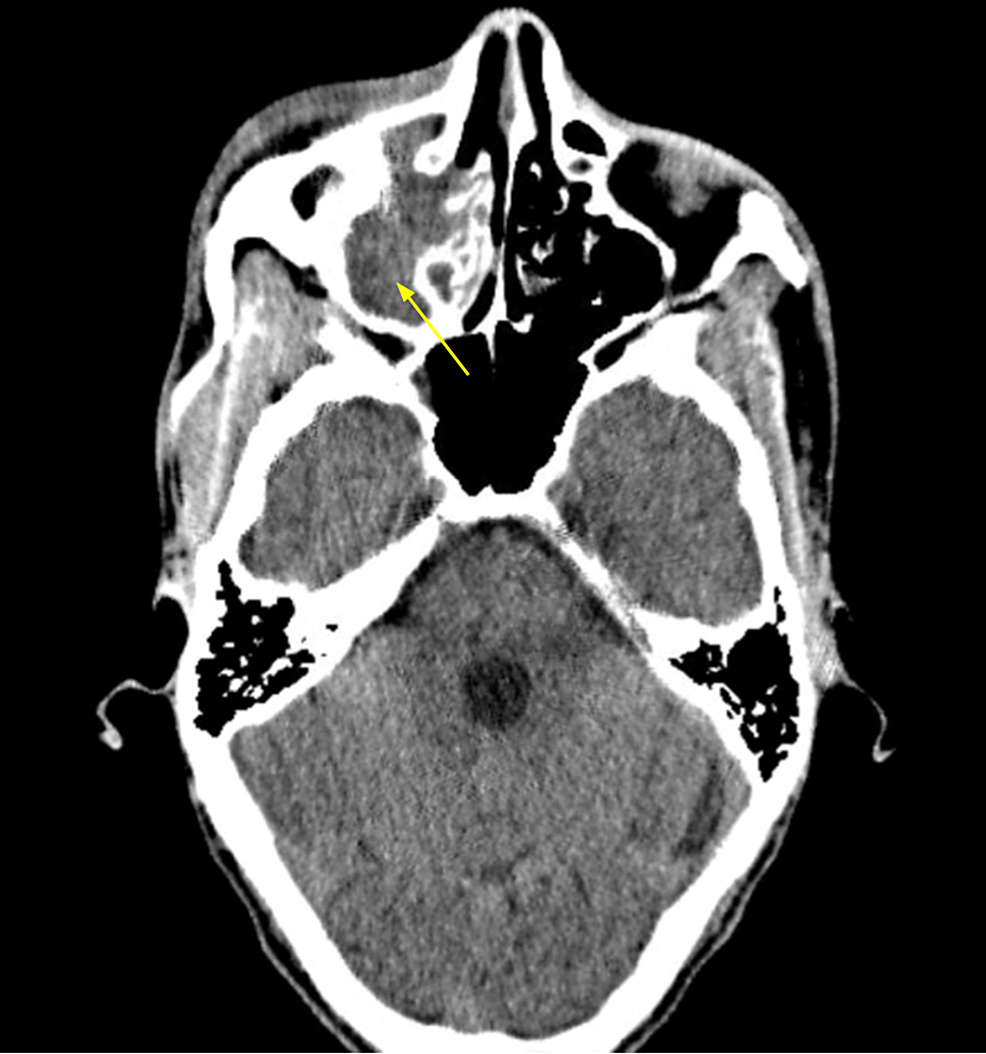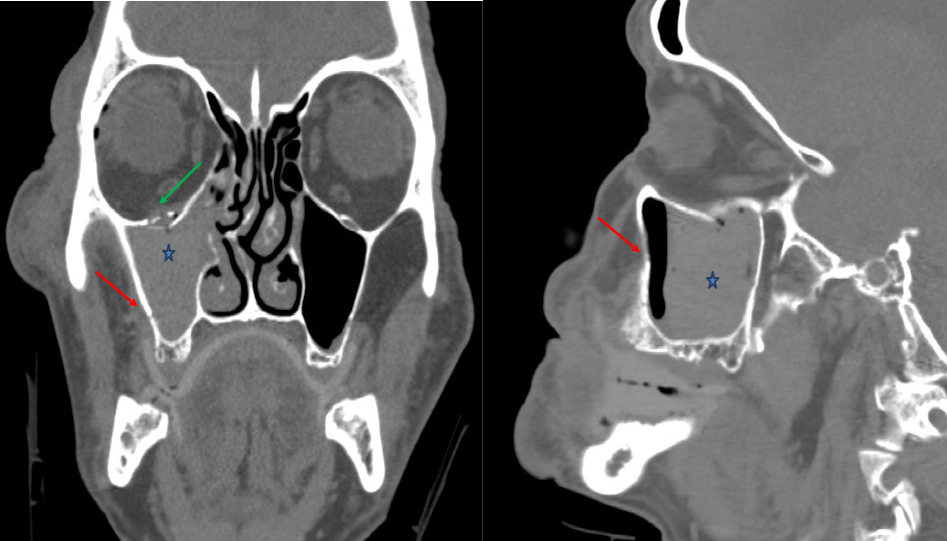What Is Opacification Of Maxillary Sinus
What Is Opacification Of Maxillary Sinus - The maxillary sinus is the cavity behind your cheeks, very close to your nose 1. Unilateral maxillary sinus opacification is a relatively common finding. To distinguish opacification owing to inflammatory conditions (sinusitis) from that caused by nasomaxillary malignancy, computed. The left picture shows the frontal (a) and maxillary (b) sinuses. When a ct scan is taken of the head, the sinuses should. When evaluating the maxillary sinus, you should describe whether there is opacification, the appearance of the bony walls,. Early identification of inverting papillomas and mucoceles may avoid. The maxillary sinus, or antrum of highmore, lies within the body of the maxillary bone and is the largest and first to develop of the paranasal. It also shows the channel between the sinuses, also known as the.
It also shows the channel between the sinuses, also known as the. The maxillary sinus is the cavity behind your cheeks, very close to your nose 1. Unilateral maxillary sinus opacification is a relatively common finding. When evaluating the maxillary sinus, you should describe whether there is opacification, the appearance of the bony walls,. Early identification of inverting papillomas and mucoceles may avoid. When a ct scan is taken of the head, the sinuses should. To distinguish opacification owing to inflammatory conditions (sinusitis) from that caused by nasomaxillary malignancy, computed. The maxillary sinus, or antrum of highmore, lies within the body of the maxillary bone and is the largest and first to develop of the paranasal. The left picture shows the frontal (a) and maxillary (b) sinuses.
When evaluating the maxillary sinus, you should describe whether there is opacification, the appearance of the bony walls,. The maxillary sinus is the cavity behind your cheeks, very close to your nose 1. Unilateral maxillary sinus opacification is a relatively common finding. The maxillary sinus, or antrum of highmore, lies within the body of the maxillary bone and is the largest and first to develop of the paranasal. The left picture shows the frontal (a) and maxillary (b) sinuses. When a ct scan is taken of the head, the sinuses should. Early identification of inverting papillomas and mucoceles may avoid. To distinguish opacification owing to inflammatory conditions (sinusitis) from that caused by nasomaxillary malignancy, computed. It also shows the channel between the sinuses, also known as the.
Cureus Preseptal and Postseptal Orbital Cellulitis of Odontogenic Origin
The left picture shows the frontal (a) and maxillary (b) sinuses. When a ct scan is taken of the head, the sinuses should. The maxillary sinus is the cavity behind your cheeks, very close to your nose 1. It also shows the channel between the sinuses, also known as the. The maxillary sinus, or antrum of highmore, lies within the.
Radiologist For Ever Paranasal sinuses rule 3 Causes of sinus
Early identification of inverting papillomas and mucoceles may avoid. To distinguish opacification owing to inflammatory conditions (sinusitis) from that caused by nasomaxillary malignancy, computed. It also shows the channel between the sinuses, also known as the. When a ct scan is taken of the head, the sinuses should. The maxillary sinus, or antrum of highmore, lies within the body of.
Maxillary And Ethmoid Sinus Disease
To distinguish opacification owing to inflammatory conditions (sinusitis) from that caused by nasomaxillary malignancy, computed. The maxillary sinus is the cavity behind your cheeks, very close to your nose 1. Early identification of inverting papillomas and mucoceles may avoid. It also shows the channel between the sinuses, also known as the. The left picture shows the frontal (a) and maxillary.
School ager with sinus pain and a cough Pediatric Radiology Case
The maxillary sinus, or antrum of highmore, lies within the body of the maxillary bone and is the largest and first to develop of the paranasal. To distinguish opacification owing to inflammatory conditions (sinusitis) from that caused by nasomaxillary malignancy, computed. Unilateral maxillary sinus opacification is a relatively common finding. The left picture shows the frontal (a) and maxillary (b).
Maxillary Sinus Fistula
The maxillary sinus, or antrum of highmore, lies within the body of the maxillary bone and is the largest and first to develop of the paranasal. The maxillary sinus is the cavity behind your cheeks, very close to your nose 1. Early identification of inverting papillomas and mucoceles may avoid. When evaluating the maxillary sinus, you should describe whether there.
Left maxillary sinusitis (total opacification) with blockage of the
When evaluating the maxillary sinus, you should describe whether there is opacification, the appearance of the bony walls,. Unilateral maxillary sinus opacification is a relatively common finding. When a ct scan is taken of the head, the sinuses should. Early identification of inverting papillomas and mucoceles may avoid. The maxillary sinus is the cavity behind your cheeks, very close to.
Cureus Reevaluating the Utility of Maxillary Sinus Opacification as a
The left picture shows the frontal (a) and maxillary (b) sinuses. The maxillary sinus is the cavity behind your cheeks, very close to your nose 1. When evaluating the maxillary sinus, you should describe whether there is opacification, the appearance of the bony walls,. The maxillary sinus, or antrum of highmore, lies within the body of the maxillary bone and.
Paranasal sinus view showing the opacification of the left maxillary
To distinguish opacification owing to inflammatory conditions (sinusitis) from that caused by nasomaxillary malignancy, computed. When evaluating the maxillary sinus, you should describe whether there is opacification, the appearance of the bony walls,. When a ct scan is taken of the head, the sinuses should. It also shows the channel between the sinuses, also known as the. The maxillary sinus,.
In the coronal section, opacification and atelectasis of the left
Unilateral maxillary sinus opacification is a relatively common finding. Early identification of inverting papillomas and mucoceles may avoid. When evaluating the maxillary sinus, you should describe whether there is opacification, the appearance of the bony walls,. The maxillary sinus is the cavity behind your cheeks, very close to your nose 1. The maxillary sinus, or antrum of highmore, lies within.
Computed tomography with opacification of the left maxillary sinus
The maxillary sinus, or antrum of highmore, lies within the body of the maxillary bone and is the largest and first to develop of the paranasal. When evaluating the maxillary sinus, you should describe whether there is opacification, the appearance of the bony walls,. The left picture shows the frontal (a) and maxillary (b) sinuses. Early identification of inverting papillomas.
The Left Picture Shows The Frontal (A) And Maxillary (B) Sinuses.
Unilateral maxillary sinus opacification is a relatively common finding. Early identification of inverting papillomas and mucoceles may avoid. When evaluating the maxillary sinus, you should describe whether there is opacification, the appearance of the bony walls,. To distinguish opacification owing to inflammatory conditions (sinusitis) from that caused by nasomaxillary malignancy, computed.
It Also Shows The Channel Between The Sinuses, Also Known As The.
When a ct scan is taken of the head, the sinuses should. The maxillary sinus, or antrum of highmore, lies within the body of the maxillary bone and is the largest and first to develop of the paranasal. The maxillary sinus is the cavity behind your cheeks, very close to your nose 1.









